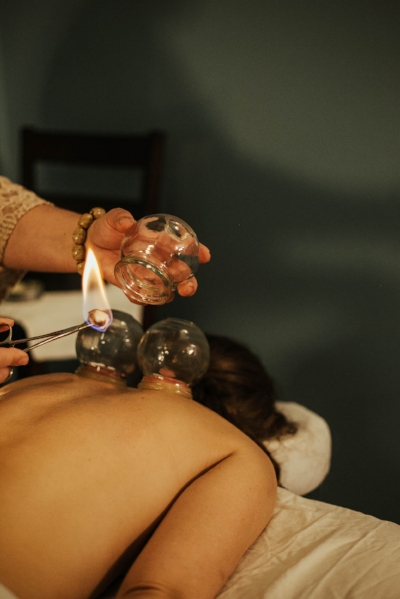Cupping
Cupping involves the placement of glass or silicone cups onto the skin by creating a suction with the use of fire, hence the name fire cupping. The suction provided by cupping can loosen muscles, encourage blood flow, and sedate the nervous system (which makes it an excellent treatment for high blood pressure). Cupping is used to relieve back and neck pains, stiff muscles, anxiety, fatigue, migraines, rheumatism, and even cellulite. Acupuncturists use cupping for common colds with a tight chest, asthma, and other breathing problems where the lungs might be full of phlegm or feel congested or tight.
Is Cupping Safe?
Cupping is generally safe when applied by trained professional acupuncturist on people who are healthy. It is not recommended for people with open skin lesions or skin sensitivities. Cupping is typically done in conjunction with a regular acupuncture session. Side effects may include bruising, burns, pain, and/or skin infection.
Does it Hurt?
cupping is a sort of myo-facial release and typically feels like a strong massage depending on how extreme the suction is in the cups. The suction can be regulated by your practitioner to avoid any unnecessary discomfort.
Why get Cupping done?
This treatment is also valuable for the lungs, and can clear congestion from a common cold or help to control a person's asthma. In fact, respiratory conditions are one of the most common maladies that cupping is used to relieve.
Cupping has a detoxifying effect on the skin and circulatory system, with a visible improvement in skin color after three to five treatments. Cupping removes toxins and improves blood flow through the veins and arteries. Especially useful for athletes is cupping’s potential to relieve muscle spasms.
Cupping also affects the digestive system. A few benefits include an improved metabolism, relief from constipation, a healthy appetite, and stronger digestion.
A 2015 report published in the Journal of Traditional and Complementary Medicine noted cupping as an effective alternative method of treating acne, pain, facial paralysis, cervical spondylosis, and herpes zoster.
Are there any Risks?
The risks of cupping are low when you have a competent, licensed practitioner. . Common side effects include soreness and minor bleeding or bruising where the cups were placed. Not everyone is a good candidate for cupping. You may be at risk of complications if you:
Have a bleeding disorder. Your chances of bleeding or bruising from the increase increase if you have a bleeding disorder or if you're taking blood thinners. This does not mean you cannot get cupping but it does mean your acupuncturist will take extra precautions to minimize bleeding or bruising so please let your acupuncturist know.
Have a open skin lesions. Please let your acupuncturist know if you have a open skin lesion in advance so they can avoid those areas.
Sensory issues or diminished pain sensitivity. Please let your practitioner know
How you prepare?
No special preparation is required before acupuncture treatment. You might want to have a snack before your session so as to avoid being hungry while trying to relax. Most people find cupping very relaxing or pleasurable.

